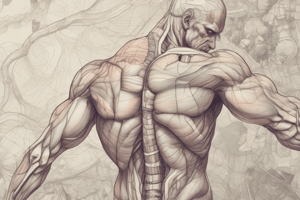Podcast
Questions and Answers
What is the most likely diagnosis for a 4-year-old boy who has a waddling gait and increasing difficulty rising from a sitting position?
What is the most likely diagnosis for a 4-year-old boy who has a waddling gait and increasing difficulty rising from a sitting position?
- Metabolic Myopathy
- Duchenne Muscular Dystrophy (correct)
- Spinal Muscular Atrophy
- Cerebral Palsy
Which of the following statements accurately describes the genetic basis of Duchenne Muscular Dystrophy?
Which of the following statements accurately describes the genetic basis of Duchenne Muscular Dystrophy?
- It is inherited in an autosomal dominant manner.
- It is inherited as an X-linked recessive trait. (correct)
- It affects only females due to its dominant inheritance.
- It is a spontaneous mutation with no family history.
What is the mechanism of disease underlying Duchenne Muscular Dystrophy?
What is the mechanism of disease underlying Duchenne Muscular Dystrophy?
- Decreased muscle fiber regeneration
- Absence of dystrophin protein (correct)
- Overproduction of muscle proteins
- Excessive mitochondrial activity
What are the obligatory criteria that distinguish muscular dystrophies from other neuromuscular diseases?
What are the obligatory criteria that distinguish muscular dystrophies from other neuromuscular diseases?
Which statement regarding the clinical presentation of Duchenne Muscular Dystrophy is true?
Which statement regarding the clinical presentation of Duchenne Muscular Dystrophy is true?
What is the incidence rate of Duchenne Muscular Dystrophy among liveborn infant boys?
What is the incidence rate of Duchenne Muscular Dystrophy among liveborn infant boys?
What does the term 'dystrophy' indicate in the context of muscular dystrophies?
What does the term 'dystrophy' indicate in the context of muscular dystrophies?
Which clinical sign is most likely to be the initial indication of Duchenne Muscular Dystrophy in infancy?
Which clinical sign is most likely to be the initial indication of Duchenne Muscular Dystrophy in infancy?
What percentage of normal dystrophin content is typically present in individuals with Duchenne Muscular Dystrophy?
What percentage of normal dystrophin content is typically present in individuals with Duchenne Muscular Dystrophy?
Which feature is associated with muscle fiber degeneration in muscular dystrophies?
Which feature is associated with muscle fiber degeneration in muscular dystrophies?
Flashcards are hidden until you start studying
Study Notes
Case Scenario
- Concerns arise for a 4-year-old boy's walking ability; he started at 16 months and presents clumsiness and frequent falls.
- Parents were previously reassured by a pediatrician that he would "outgrow" his clumsiness.
- Child demonstrates a "waddling" gait and difficulty rising from the floor in the last month.
Possible Diagnosis
- Likely diagnosis is a form of Muscular Dystrophy, specifically Duchenne Muscular Dystrophy (DMD).
Diagnostic Test
- The diagnostic test of choice for Muscular Dystrophies is genetic testing, particularly to check for mutations in the dystrophin gene.
Mechanism of Disease
- Muscular dystrophy involves abnormal muscle growth and degeneration, rooted in genetic mutations affecting muscle fiber function.
- It is characterized by being a primary myopathy with a genetic basis, progressive course, and eventual degeneration of muscle fibers.
Duchenne Muscular Dystrophy (DMD)
- DMD is the most prevalent hereditary neuromuscular disorder, affecting all racial and ethnic groups.
- The incidence rate is approximately 1 in 3,600 liveborn infant boys.
- Inherited via X-linked recessive trait, with the abnormal gene located at the Xp21 locus.
- Dystrophin, a key structural protein, is markedly deficient in DMD, ranging from 0% to 5% of normal levels.
Clinical Presentation
- Boys with DMD are usually asymptomatic at birth or in early infancy but may exhibit mild hypotonia.
- Gross motor developments such as rolling over, sitting, and standing may occur on time or with slight delays.
- Typically, children start walking around the age of 12 months, but hip girdle weakness can start subtly by the age of 2.
- The first observable sign might be delayed head control during infancy.
Studying That Suits You
Use AI to generate personalized quizzes and flashcards to suit your learning preferences.



